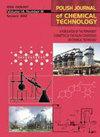盐酸比硫酸产生更高纯度的氨基葡萄糖:不同检测方法的比较研究
IF 1
4区 工程技术
Q4 CHEMISTRY, APPLIED
引用次数: 0
摘要
本研究使用 HCl 和 H2SO4 比较了从虾壳干甲壳素中生产葡萄糖胺的最佳条件。结果表明,盐酸水解的最佳条件是 12 M、80 °C、2 小时,甲壳素与酸的体积比为 1:20;而 H2SO4 的最佳水解条件是 6 M、90 °C、5 小时,甲壳素与酸的体积比为 1:20。与 H2SO4 相比,盐酸产生的固化葡糖胺产量更高。此外,我们的研究结果表明,使用紫外检测器可以检测到微弱信号的葡糖胺,而我们建议使用 RI 检测器检测到更强的信号。盐酸水解法产生的甲壳素最高产率为 283.9 ± 13.8 mg Gln g-1,与其他研究结果不相上下,但盐酸和 H2SO4 的使用情况比较突出。本文章由计算机程序翻译,如有差异,请以英文原文为准。
Hydrochloric acid producing higher purity of glucosamine than sulfuric acid: a comparison study with different detection approaches
In this study, HCl and H2 SO4 were used to compare the best conditions for producing glucosamine from the dry chitin of shrimp shells. The results showed that for HCl hydrolysis, the most favored conditions were 12 M, 80 °C, 2 hours, and a chitin-to-acid volume ratio of 1:20, whereas, for H2 SO4 hydrolysis, the most favored conditions were 6 M, 90 °C, 5 hours, and a chitin to acid volume ratio of 1:20. HCl produced pured glucosamine with a higher yield than H2 SO4 . Additionally, our findings indicated that glucosamine could be detected using a UV detector with a weak signal, whereas we recommended using an RI detector for a comparably stronger signal. Our production maximum yield of 283.9 ± 13.8 mg Gln g−1 chitin from HCl hydrolysis was comparable to that of other studies, with a comparison between using HCl and H2 SO4 being highlighted.
求助全文
通过发布文献求助,成功后即可免费获取论文全文。
去求助
来源期刊

Polish Journal of Chemical Technology
CHEMISTRY, APPLIED-ENGINEERING, CHEMICAL
CiteScore
1.70
自引率
10.00%
发文量
22
审稿时长
4.5 months
期刊介绍:
Polish Journal of Chemical Technology is a peer-reviewed, international journal devoted to fundamental and applied chemistry, as well as chemical engineering and biotechnology research. It has a very broad scope but favors interdisciplinary research that bring chemical technology together with other disciplines. All authors receive very fast and comprehensive peer-review. Additionally, every published article is promoted to researchers working in the same field.
 求助内容:
求助内容: 应助结果提醒方式:
应助结果提醒方式:


